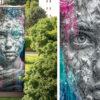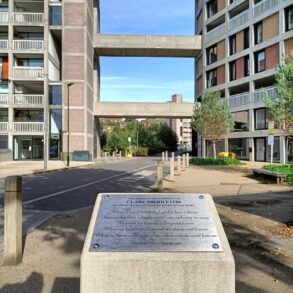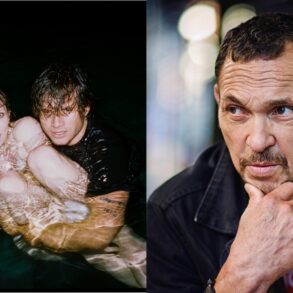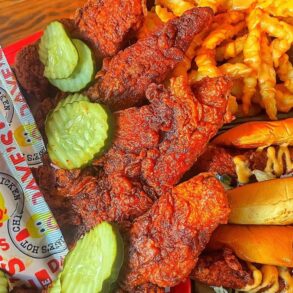This is the fifth post in our fourth season of Philly Street Art Interviews! This season is sponsored by Philadelphia International Airport (PHL) and its @PHLAirportArt program, which curates museum-quality art exhibitions that introduce millions of visitors from around the world to the vibrant artistic culture of the region. PHL proudly supports Philly arts and culture/365! Interview and photos by Streets Dept Lead Contributor Eric Dale.
Luíza Cardenuto is a Philly-based linocut printmaker born in São Paulo, Brazil. A week ago, I would have said that she’s known for her botanical wheatpastes, but I now know that Nūtō doesn’t really want to be “known for” any one thing. For her, art is more about observation, self reflection, and meditation, and creating whatever she wants is paramount.
When I stepped into Nūtō’s studio for this interview, I was blown away by the sheer volume of creative output on display. There are huge prints on the tables. There’s a massive slab of linoleum on the wall that she’s currently carving. There are drawers full of designs I’ve never seen from her before. And there are two sets of double doors in the hallway, which she painted on both sides for an informal art show hosted several years ago by the tenants of the building her studio is in. On my way out, with the help of a curious squirrel, I realized that even the mural in the building’s parking lot is hers, too!
Nūtō has been wheatpasting in Philly for eight years now, but the quantity of art she’s put on the streets belies the vast depth of her creative practice. I say this not to undercut her street art output, but rather to underscore her creative drive. It propels her without a need for vindication or validation, and has led her to join the ranks of Philly street artists who create simply because deep down in their soul, they must.
But validation she deserves nonetheless! Her sketched yet polished style is appealing, and executed to great effect in her hand-pressed prints, which are often meticulously cut before pasting. (Imagine cutting out the silhouette of a Monstera—there are so many little notches and stalks and holes!) Frankly, I think you should go follow her on Instagram right now. Her original account was compromised by a phishing attack in 2022, and she would love to connect with fans new and old.
Streets Dept’s Eric Dale: Tell me about your background.
Luíza Cardenuto: Background in art is, basically, when I was a kid, I loved to draw and paint and do all craftsy stuff. I was very different from my siblings. I just stayed by myself and drew all the time. Then, when I was a teenager, I moved to the United States. In Brazil, I didn’t really know that art was even a career. And when I moved here, I saw that it was. So I went to the School of Visual Arts in New York, for visual and critical studies, which wasn’t, like, fine art, but it gave me the background to express myself—not just through art, but also through writing and speaking—and just understanding art in general, because I had never really been exposed to the art world. And then I moved to Philadelphia and actually took it more seriously. But yeah, from Brazil to Miami and New York and then here with street art.
SD: You’ve previously said that when you moved to Philadelphia, you felt “lost and uncertain that this city was the right city for me.” Now that you’ve been here for eight years… is Philly the right city for you?
LC: Yes, definitely. In the beginning, my comparisons were New York, Miami, and São Paulo, which are huge cities. And not to say that Philly is small at all, but for me, coming from these cities, I’m like oh, it’s too small. Haha! But I think it’s more manageable that way, and the art community is more tight. In New York, it’s so much about niche. Like if you’re a printmaker, you only hang out with printmakers. It’s hard to break the niche cliques that happen in the art world. But here, I felt like I was part of the city and I became part of the city. People like you and Streets Dept; you guys represent the art community here and it’s really cool to be part of that and feel like I’m part of something, whereas in New York, I felt like a stranger.
SD: Did you do street art when you were in New York?
LC: That’s where I started, mostly in school. I actually took a street art class at the School of Visual Arts. My teacher, he had all these street artist friends, and we would go visit them in the studio, and he took us to, like, train tracks and all kinds of weird places, and showed us graffiti, and that was when I was introduced to it. So I literally took a class on street art, and that’s what got me interested.
SD: Wow, ok! I also saw a post where you said that when you graduated from art school, you “had a strange, eerie feeling that the art world was not for me.” What did you mean by that?
LC: So in art school, you’re not really taught about what the art world really is. You’re taught to do your own thing and follow your—
SD: You mean like how to make a career of it?
LC: Yeah, and, like, how it works. How the gallery [world] works—they don’t really teach you. At least in my courses, it didn’t show up at any point; how galleries work, how curators do their job, what an art consultant is; I never really knew that.
So I graduated, and I started looking for jobs in galleries and museums and stuff, and it just… I worked for an art dealer for some time, and it was really apparent to me that it wasn’t what I was looking for—like, being that type of institutional artist. I just didn’t know how to even enter that world, and if I was going to be happy in it, because I felt like it was a rich person’s thing.
So I didn’t feel like I was part of it until I started meeting people in the street art world that were doing their thing in the streets and getting into shows and also doing community projects. I also made a lot of friends with toy designers in New York, and that was cool because that was like a whole other art world that I didn’t know about. So I understood that the art world is much bigger than we think it is. It’s not just what’s in the museum and gallery, but rather it’s in everyday life. Everything is art.
SD: I love that. So tell me more about how you transitioned from this traditional art school background to making street art.
LC: I think it was mostly being in New York that made that transition [happen]. Because when I lived in Miami—I went to school there, too—I was set on being a painter or some kind of studio artist, doing sculptures or printmaking, whatever it was. But I didn’t know that you could do art on the street. It wasn’t a thing that I thought about. But being in New York exposed me to it.
And honestly I didn’t even think of it as a transition. It was just like, people were doing it and I was like yeah, I’m gonna do it, you know? So I started by spray painting and doing stickers, and pretty soon I was like I love printmaking, and I wanted to combine that with street art, but I [couldn’t] really think of how. Then I met Swoon, and that’s when I was like oh, I can do this! I can use linoleum prints! Duh! So I started pasting. I was already doing poster designs, but I wanted to do carvings and prints and put it on the street. It felt very natural to me, like, it wasn’t even a thing that I thought about as a transition.
SD: It was just how you applied your training.
LC: Yeah. I didn’t want to wait to be invited to show things. And my friends were all doing it—it was just something that people in my school did. We would all go together.
SD: It’s good to have a crew! So do you think you would be an artist today if you had stayed in Brazil?
LC: Man, I think about that very often. And I have friends in Brazil who were artistic like me, who are becoming more artistic now, after being adults and having, making, doing all these other things that they… didn’t love? Now they’re going back to it. I think something like that would have happened to me, where I would have gone to a very serious career, and then had a breakdown at some point and been like I actually want to be an artist! But I don’t think it would have been as natural and easy for me over there, because it wasn’t something I was around much.
SD: Right, exposure is really important. What do you think an artist’s role in society is?
LC: We’re, I think, changemakers in a weird way. It’s kind of like… something happens and people [fail] to notice it. Or artists are more sensitive to what’s going on in the world; in society, in politics. And I think our role is really to digest that information and put it out there in a way that people can consume. Not in a these-are-the-facts kind of way, ‘cause that’s just news. And that’s also not healthy sometimes. But I think artists can really transcribe what is going on into feelings and emotions and imageries and concepts, and make people not just horrified or happy, but really understand something. It’s like a human connection. I think artists can build that connection between current events and the individual.
SD: I love that. Ok, so based on your Instagram posts, it seems like you’ve been having complicated feelings about art and creativity recently. Can you share what’s on your mind right now?
LC: So, being a mom was a big change. It wasn’t something I was really thinking about, ‘cause when I was pregnant for nine months, I was still coming [to my studio] and I still had my time for myself. And even though I didn’t have the same amount of energy, I was still doing my own thing; I was still the person who could do with my time what I wanted to. And now my time feels like it’s not mine anymore. This baby needs me all the time.
So I’m trying to figure out a schedule, and art has been on my back burner a little bit, not because I don’t want to dedicate any time for it—it’s just ‘cause I feel like I don’t have it. I don’t have the time or the structure, really, to try to go back to that practice. Art and motherhood has been very hard, and I don’t really know exactly how to manage it yet.
And honestly, there’s not that many artists talking about it! A lot of female artists don’t really have kids. A lot of the ones that I love and look up to have decided not to have kids, and I feel like if a female artist does have kids, it’s hard to talk about that, or there’s not really a space that we can talk about it. So I don’t know, maybe I should start talking about it more! But I feel like it’s a common thing, where a female artist has kids and art becomes the second priority. I’m trying to juggle both, but it doesn’t happen very often.
SD: Yeah, it’s that classic question that everyone hates when the morning news anchors ask: can women have it all?
LC: Exactly! And do women want it all? I don’t know if I want a crazy art career right now, ‘cause I literally can’t! I wouldn’t be able to. I don’t want to send her to daycare and then be here. It’s just hard. It’s hard to juggle both. I feel like it’s not something that is talked about much in the art world. It’s just kind of something that we assume. We’re like oh, she’s successful; she must not have kids. And usually that’s true! Because that’s a hard thing to juggle. I guess maybe when they’re off to high school, then I’ll be like yay I got time again!
SD: So you’ve written some interesting things about the personal brand and how it relates to street art. Namely, I’m thinking of what you described as a “shift” that you’ve noticed, “where a name or tagline becomes more important than the instinct to simply create art on the city walls. It has somehow become a branding strategy.” How do you see street art, if not as a brand for the artist?
LC: I mean, it’s a hard thing, because you’re putting yourself out there. It is a way to put your image or your name out there, so it is always a branding strategy or advertisement, but when it’s just that repetitive thing… I guess it’s kind of that thing with graffiti writers and street artists—that rift that we have. It’s annoying, because I make this thing, it takes so long to do it, and then I put it up, and then people just go over it! But I get it—I understand that [graffiti] is a whole genre in and of itself.
But like, you’re doing all this work—for what? I want to see what they’re about. I want to see what their message is, and not just this is the visual and this is all it is. I guess it comes from the concept artist in me, that I try to always understand art, and I know that some people don’t feel that way, but I miss that about street art.
SD: So what’s your message?
LC: Well, I try to bring more awareness to environmental destruction. That has been on my mind since I was a kid. I learned about how humans are impacting the earth from my mom. My mom used to compost and would tell me all these things about trash separating and how you do this and why we do this. And I’ve always been very conscious of it.
So I try to highlight animals that are entering extinction—or plants—and also just celebrate them. Not just like this is what’s happening. I don’t want to be a Debbie Downer all the time; I’m also trying to celebrate them. There’s things that we might not see when we’re old or that our kids might not see. And there’s plenty of plants and animals that our parents have seen or knew about, or birds that we might not see again…
SD: Or have already gone extinct.
LC: Or have already gone extinct! And it’s kind of nuts to think that a whole species can annihilate another species; that we’re the only ones that can do that, and we’re doing it at such a fast pace. So really that has always been in the back of my mind. I don’t do it as something to make people sad, but really something to just make us think, and realize this is happening.
SD: Have you picked your 2024 animal yet? I know you feature an animal every year that has either entered or left the endangered species list, right?
LC: Yes. No, I haven’t thought of a 2024 animal yet, but I should. Do you have any suggestions?
SD: Oh boy, my suggestion would be that—what was it? I want to say a mole, that was just rediscovered somewhere in Africa. It’s one of those ones where it hasn’t been seen since 1962 or whatever. And they went back to the only place where it’s ever been seen, and they set up remote cameras or whatever—one of those types of stories—and they found it! [Last observed in South Africa in 1936, the De Winton’s golden mole was rediscovered in 2023 using eDNA.]
LC: Wow. I’ve been looking at birds, because the population of birds is going down so quickly. And I think I’m gonna focus more on birds this year, only because I haven’t done that many birds. I did the eagle, but I would like to do less mammals. But yeah, something like a mole would be interesting too!
SD: I mean, I’m all in favor of highlighting something other than charismatic megafauna!
LC: Exactly, yeah. The pangolin was kind of that. But also because I probably won’t be making large scale work so much. I’m trying to downsize a little bit, mostly because my life has become very hectic, so, birds can fit in a smaller frame. Whereas a big animal, it’s just hard to make it small and not make it too much like a toy.
SD: In that same post where you wrote about the shift you’ve seen, you wrote “somehow, in one of the most diverse areas in the art world, street art, it has became a requirement to have a recognizable style.” It sounds like you think that shouldn’t be a requirement?
LC: I mean, it’s not a requirement. I feel like it’s become about social media, and when art becomes about being recognized online, you lose so much of what it is. Of course as an artist you’re gonna have a style, because you have a preference for how you draw things or paint things, but I think that we lose the full scope of their vision when it’s more important to us to recognize them than to see what they are about.
For me, when people say that I’m the plant artist ‘cause I paste a lot of plants, I’m like oh man, maybe I shouldn’t be pasting plants anymore, ‘cause I don’t want to be recognized by one thing. I want to be me! Yeah, I have a style, and I think artists should develop their style; it’s important. It’s nice to put yourself in a box sometimes because you create better work from that. But when it’s just about this is what I share on social media; this is how my feed looks, and if I diverge from that, people might not recognize me and I’m not going to do anything like that, that’s when I think we start losing, just, the evolution of art as a society.
We just have to be more mindful of it and support artists when they’re doing something different. I think that’s what it is. A lot of people that I know try something new, and people that used to support them are like oh, I don’t like this style. But it’s important that artists make mistakes and that we evolve, and to feel like that’s not something your community is going to support can hinder evolution. It’s sad to see sometimes, that people are trying not to do something different because their followers might not like it. I think it has a lot to do with the internet and I feel sad that that is the way that we’re going.
I think that’s changing back… maybe because of the pandemic? I think everybody was exploring more and trying to be different more. So there has been a shift back into I’m trying different things and I’m gonna try this style that I haven’t tried, or this method or this material. But, yeah, I think that’s really what it is. When you’re too locked into that one style and too preoccupied with what your followers like, then you don’t necessarily evolve.
SD: So how would you describe your style?
LC: So, I love printmaking. There’s just a love that I have for the medium that has been with me forever. I love Goya and all the old school linoleum or etchings. I just love the medium of printing; like, I’m fascinated by what printing has done to society. But… I don’t know how to describe my style. My drawing style is very much based on nature. I love to look at botany drawings and make rough sketches. I don’t think that my style is very refined and I like that about it. But yeah, I’m really bad at describing my style.
SD: That’s ok! Ok, so rapidfire, I want to ask you about some of the most common imagery that can be seen in your artworks. And I want you to just tell me what comes to mind or how you think about these subjects. So… plants.
LC: I love the way we interact with plants. You’re wearing a shirt full of plants now! And it just makes us happy. When people look at plants, we smile. It makes a room better to be in, and the shades of green… I think that as humans, we should be around plants more, so I like to draw them because they make people smile and I smile when I draw them.
SD: Okay! Animals.
LC: I think there’s a sense that I’m trying to understand them? I’m trying to understand what animals are in a way that I will never understand them. So by analyzing their bodies and anatomy, I think that I understand them a little more. Almost like an artistic scientist.
SD: Interesting. Mandalas.
LC: I have a very spiritual relationship with mandalas, because for a long time, I didn’t make art. After I graduated from school, I was working, and I was kind of stuck. I didn’t know what to make. And I started drawing mandalas just ‘cause of the spiritual part of it, like how you can meditate and draw. And I started drawing them and started incorporating the patterns of things that I saw around, so whatever I saw, I would incorporate that into the design of the mandala. I became very attached to the form—to the circle, and creating something from the center that expands. It expands me, too, every time I’m doing it. If there’s a subject that I’m thinking about and I draw a mandala related to it, it makes me think better about that thing. It just makes me understand that subject better. And I think it’s part of us—the circle is a spiritual shape, and I just love that it can be used in that way for meditation and for understanding something.
SD: Tell me about your urban totem pole series. I really know nothing about it!
LC: Yeah, I don’t think many people know about it. I started drawing totem poles after a few visits to Hawai’i because I would get these totem poles, and each one means something. One is supposed to bring you happiness; one is supposed to bring you money, and it’s a thing that you get in gift shops and stuff. I made this little collection, and then I started drawing my own—basically characters on top of each other and random things. And I became really into that sort of drawing.
I guess I like drawing inside of shapes—it comes from the mandala. It’s drawing inside of a circle, and then drawing inside of a cylinder, or a rectangle. Giving myself a box to draw inside of, or a nice composition… because otherwise I would just go crazy and I would just keep drawing the whole page. But giving myself shapes I think makes it easier to know when to stop. So I did a bunch of these drawings and then I started to print them and I honestly don’t know what to do with them. But I’m trying to get back into putting them out, maybe putting them more on, like, street posts or side walls and stuff.
SD: What’s your favorite experience you’ve had while wheatpasting?
LC: Oh man, there’s so many. The best one was probably on Spring Garden. It was when the lockdown was happening, and I was pasting something on a construction site. I started pasting and these kids were playing on the side; they were, like, the neighbors. And they came out and they started helping me!
It just became this whole art thing. The kids came and they started helping, and the mom was helping me too. It just became a whole day. I was there for four hours. I meant to be there for five minutes and leave. But then the kids were all into it and they pasted a bunch of stuff, and the wheatpaste was really random, because they started pasting it everywhere. It was just cool to see. I guess because of the pandemic, we were all trying to stay distant and it was cool to have that experience during that time.
So impromptu too, ‘cause usually when you do street art projects like that, you have to plan for it. You have to, like, let people know and ask if everything is cool, and at first, when the mom came out and the kids came out, I thought they were gonna curse at me, like what are you doing?! I thought they were not liking what I was doing, and the kids started being like oh, can we help you? So they got the brush, and started putting glue everywhere, and they all got dirty… It was hilarious, and it ended up being a whole thing, and everything was just shut down around us, so nobody cared. It was cute.
SD: That’s great. And I’m sure they were dying to have something interesting to do and interact with other people!
LC: Yeah! There’s a lot of things like that, when kids get involved, that I love. And I guess in a way, I do animals because of that—I like that my imagery is approachable and people are not questioning it. I don’t want people to feel like this is ugly; don’t do it. People like when I put my work up ‘cause they’re like oh, it’s nice; it looks nice! So that’s one reason, I think, deep inside: I want to make pretty things for the streets.
SD: Thank you!
LC: Thank you!
This post was originally published on this site be sure to check out more of their content.









